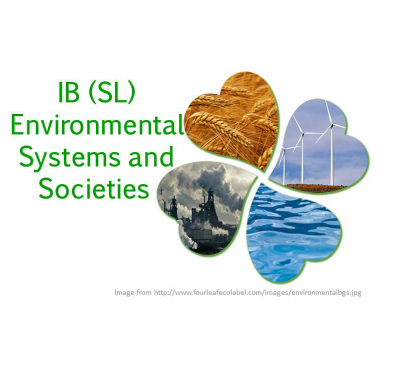
Taken from: https://www.mrgscience.com/ibdp-environmental-systems-and-societies.html
I. INTRODUCTION:
Environmental Systems and Societies is an interdisciplinary course (groups 3 and 4). Its purpose is to elaborate a scientific exploration of environmental systems and the cultural, political, economic and social interaction of the societies and the environment.
II. GENERAL OBJECTIVE:
Appreciate the dynamic interconnectedness between environmental systems and societies
III. COMPETENCES / ABILITIES TO DEVELOP
○ Demonstrate knowledge and understanding of relevant:
i. Facts and concepts
ii. Methodologies and techniques
iii. Values and attitudes
○ Apply this knowledge and understanding in the analysis of:
i. Explanations, concepts and theories
ii. Data and models
iii. Case studies in unfamiliar contexts
iv. Arguments and value systems
○ Evaluate, justify and synthesize, as appropriate:
i. Explanations, theories and models
ii. Argument and proposed solutions
iii. Methods of fieldwork and investigation
iv. Cultural viewpoints and value systems
○ Engage with investigations of environmental and societal issues at the local and global level through
i. Evaluating the political, economic and social contexts of issues
ii. Selecting and applying the appropriate research and practical skills necessary to carry out investigations
iii. Suggesting collaborative and innovative solutions that demonstrate awareness and respect for the cultural differences and value systems of others.
IV. METHODOLOGY
○ Lectures
○ Student presentations (individual and group)
○ Workshops
○ Mocks (Paper 1 and Paper 2)
○ Quizzes
○ Projects
V. CONTENT AND CONCEPTS
1. Foundations of environmental systems and societies
a. Environmental value systems
b. Systems and models
c. Energy and equilibria
d. Sustainability
e. Humans and pollution
2. Ecosystems and ecology
a. Species and populations
b. Communities and ecosystems
c. Flows of energy and matter
d. Biomes, zonation and succession
e. Investigating ecosystems
3. Biodiversity and conservation
a. An introduction to biodiversity
b. Origins of biodiversity
c. Threats to biodiversity
d. Conservation of biodiversity
4. Water and aquatic food production systems and societies.
a. Introduction to water systems
b. Access to freshwater
c. Aquatic food production systems
d. Water pollution
5. Soils Systems and terrestrial food production systems and societies.
a. Introduction to soil systems
b. Terrestrial food production systems and food choices.
c. Soil degradation and conservation.
6. Atmospheric Systems and Societies
a. Introduction to the atmosphere
b. Stratospheric Ozone
c. Photochemical smog
d. Acid deposition
7. Climate change and energy production
a. Energy choices and security
b. Climate change – causes and impacts.
c. Climate change – mitigation and adaptation
8. Human systems and resource use
a. Human population dynamics
b. Resource use in society
c. Solid domestic waste
d. Human population carrying capacity
|
Evaluation Criteria |
Percentages |
|
Internal Assessment |
20 |
|
Class Activities |
25 |
|
Quizzes |
15 |
|
Exams mocks |
40 |

- Profesor: Osmar Julian Martinez Lopez
- Profesor: Pauline Perry Arbelaez
- Profesor: Emmanuel Ramirez Cardenas
- Profesor: Jhonnyer Julian Valencia Arredondo